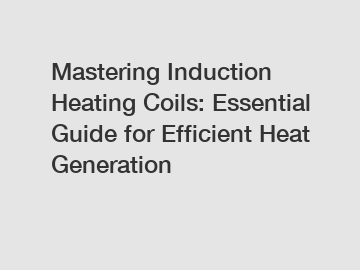Mastering Induction Heating Coils: Essential Guide for Efficient Heat Generation
Welcome to our comprehensive guide on mastering induction heating coils, an invaluable tool for efficient heat generation in various industries. Induction heating coils leverage electromagnetic fields to generate heat quickly and precisely, making them a popular choice in numerous applications. In this article, we will delve into the intricacies of induction heating coils, discussing their construction, working principles, key considerations, and benefits.
Understanding Induction Heating Coils.
Induction heating coils are essential components that enable the transfer of electrical energy into heat. These coils consist of tightly wound conductive wires, typically made of copper or aluminum, arranged in a specific pattern. The pattern and configuration of the coil directly influence the distribution and intensity of the electromagnetic field generated.

Working Principle of Induction Heating Coils.
Induction heating relies on the principles of electromagnetic induction. When alternating current (AC) flows through the coil, an electromagnetic field is created around it. The alternating magnetic field then induces eddy currents in conductive materials positioned within the field's influence. These eddy currents, in turn, produce heat due to the inherent electrical resistance of the material.
Factors Influencing Efficiency.
Efficient heat generation is crucial in industrial applications, and several factors play a vital role in optimizing the performance of induction heating coils. Let's explore some key considerations to harness the full potential of this technology.
1. Coil Design and Construction: The design, shape, and sizing of the coil all impact the efficiency and effectiveness of heat generation. Factors such as coil height, width, and the number of turns influence the concentration and penetration of the electromagnetic field.
2. Material Selection: Using high-quality conductive materials, such as copper or aluminum, ensures optimal heat transfer and reduced energy losses. Proper insulation materials are also essential to prevent energy dissipation and minimize coil heating.
3. Frequency Selection: The frequency at which the AC current oscillates affects the depth of heat penetration and the materials that can be efficiently heated. Choosing the right frequency based on the application requirements is crucial for maximizing heating efficiency.
4. Cooling Mechanisms: Induction heating coils generate a substantial amount of heat during operation. Efficient cooling mechanisms, such as water cooling channels within the coil structure, ensure consistent performance and prolong coil life.
Benefits of Induction Heating Coils.
Induction heating coils offer numerous advantages that contribute to their wide adoption across various industries.
1. Rapid and Precise Heating: Induction heating coils allow for fast and accurate heating, thanks to their ability to generate intense heat directly within the target material. This improves production efficiency, reduces cycle times, and minimizes energy consumption.
2. Selective Heating: Induction heating coils can selectively heat specific areas of a material, offering localized treatment, such as hardening, tempering, and brazing. This precise control minimizes the risk of damage or distortion to surrounding areas.
3. Uniform Heating: By carefully designing the coil pattern and adjusting current flow, uniform heating across the target material can be achieved. This eliminates temperature variations and enhances product quality and consistency.
4. Energy Efficiency: Induction heating is highly energy-efficient compared to traditional heating methods. The ability to heat only the desired material, combined with rapid heating times, results in significant energy savings and reduced environmental impact.
Conclusion.
Mastering induction heating coils can unlock a vast range of possibilities for efficient heat generation in various applications. By understanding the intricacies of coil design, selecting appropriate materials, and optimizing operating parameters, industries can harness the power of electromagnetic induction to their advantage. The benefits of induction heating, including fast heating, precise control, uniformity, and energy efficiency, make it a valuable technology for improved productivity, quality, and environmental sustainability.
So, explore the endless possibilities of induction heating coils and pave the way for transformative innovations in your industry!
For more industrial induction heating equipment, pipe heat bending system, copper tube induction brazing equipmentinformation, please contact us. We will provide professional answers.


